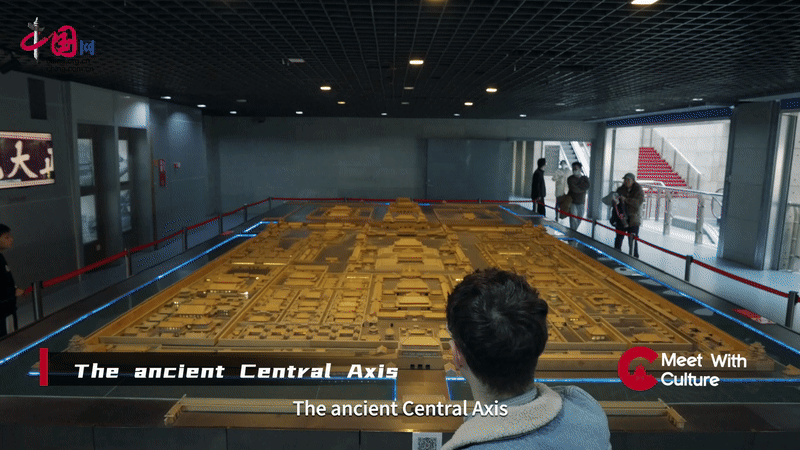We will stay firmly rooted in Chinese culture. We will collect and refine the defining symbols and best elements of Chinese culture and showcase them to the world. We will accelerate the development of China’s discourse and narrative systems, better tell China’s stories, make China’s voice heard, and present a China that is credible, appealing, and respectable.
Meet With Culture | Beijing Central Axis: A Time Tunnel of 700 Years
发布时间:2024-12-11 09:16:30 | 来源:中国网-中国习观 | 作者: | 责任编辑:曹川川
Beijing, a city of historical significance, has built a unique and magnificent architectural landscape along its time-honored Central Axis. The Central Axis not only reflects Beijing's urban planning and development, but also has historical and cultural significance, manifesting China's traditional urban planning theory and the Chinese philosophy of "respecting the middle".
Someone said that if you want to understand a city, you need to start with understanding its layout. When it comes to Beijing, what can't be bypassed is the Central Axis and the symmetrical aesthetics embedded in this ancient city.

The Beijing Planning Exhibition Hall, located on Qianmen East Street in Dongcheng District, was converted from an existing building and opened to the public in 2004. Roaming through the exhibition hall, it feels like a blueprint for Beijing's urban development was unfolding before your eyes, vividly showing the stories of Beijing's continuous growth around the ancient Central Axis.

Beijing is embraced by the Yanshan Mountains in the north and the Taihang Mountains in the west. The small plain surrounded by the two mountain ranges is called the Beijing Plain, which was formed by the joint alluvium of the Yongding and Chaobai rivers. Considering that its shape resembles a semi-enclosed bay, the topography is geographically called "Beijing Gulf".
The ancient Central Axis, built in the Yuan Dynasty (1271-1368), is about 7.8 kilometers long, stretching from the Bell and Drum Towers in the north to the Yongding Gate in the south.
Through this Central Axis of the Yuan-Dynasty imperial city, we can understand how ancient Chinese people conveyed political ideas through urban planning and layout, and explore their expression of traditional Chinese culture and aesthetics.

The ancient Central Axis emphasized the concept of "respecting the middle" in terms of layout and structure. It emphasized the imperial power and authority through building the imperial palace and other important ritual facilities in the center of the city and relevant blocks. This design also contains rich historical and cultural connotations, highlighting the pursuit of harmony and unity in Chinese culture through centered and symmetrical layouts in urban planning.
The urban axis, checkerboard-shaped road system and water system formed during that period have basically been preserved to this day. They have witnessed the origins of the capital city of Beijing and its changes over the past few centuries.
Behind the Central Axis that dominates Beijing's magnificent order was the hard work of planners and artisans of the past dynasties.

The relief sculpture "The Old City of Beijing 1949" was crafted according to a hand-drawn survey map. At a scale of 1:1000, it reflects the overall layout and characteristics of Beijing in 1949. The entire sculpture was cast with bronze, with a weight of nearly ten tons. The bronze map is nine meters long and ten meters wide.
Through the relief sculpture depicting old Beijing, we can overlook the Central Axis of the city in 1949 and directly see the location of the Central Axis of Beijing back then.
The north-south Central Axis and the east-west Chang'an Avenue converge in front of Tiananmen Square, one vertical and one horizontal, dominating the function and spatial layout of the old district of Beijing. Later, we will look for these two lines on the sand table for today's Beijing, which showcase the development of the city.
In recent years, Beijing has replaced the concept of "old district reconstruction" with "old city protection". Along the Central Axis running through the old district of Beijing, the city works to restore historical buildings, improve the living environment, and advance the overall protection of the old city.

The Beijing urban planning sand table on the third floor adopts a scale of 1:750, with the models totaling 302 square meters and picturing totaling 1,000 square meters, which vividly showcases the impressive look of modern Beijing.
Over the past 700 years, Beijing Central Axis has undergone many changes, witnessing the remarkable vitality of this immortal city. In the new era, the Central Axis still dominates the spatial layout of Beijing, calling for humanistic sentiment in the harmonious natural environment comprised of mountains and rivers. The extension of the Central Axis reaches the Yanshan Mountains in the north and the Yongding River in the south, becoming an important part of Beijing's spatial structure comprised of "the core zone, the central area and the BMC, two axes, multiple new towns and an eco-zone".
The time-honored Central Axis is a golden name card of Beijing. It is a shared aspiration of the Chinese people to inherit and protect this precious cultural heritage. Through respecting and protecting the layout of mountains and rivers, strengthening the perfect integration of urban construction and natural landscapes, and highlighting the characteristics of urban landscapes, it inspires every Chinese's nostalgia of the traditional philosophy of "respecting the middle".
(Executive Producer: Wang Xiaohui; Production Supervisor: Xue Lisheng; Line Producer: Yu Li; Chief Planner: Ding Suyun, Cao Chuanchuan; Planner: Li Ying; Translator: Liu Haile)

